French Polynesia
| French Polynesia |
||||||
|---|---|---|---|---|---|---|
|
||||||
Motto:
|
||||||
| Anthem: La Marseillaise (French) | ||||||
.svg.png) |
||||||
| Status | Overseas collectivity | |||||
| Capital | Pape'ete 17°34′S 149°36′W / 17.567°S 149.600°W | |||||
| Largest city | Fa'a'ā | |||||
| Official languages | French | |||||
| Ethnic groups (1988[1]) |
|
|||||
| Demonym | French Polynesian | |||||
| Sovereign state | France | |||||
| Government | Dependent territory | |||||
| - | President of France | François Hollande | ||||
| - | President of French Polynesia | Édouard Fritch | ||||
| - | High Commissioner | Lionel Beffre | ||||
| Overseas collectivity of France | ||||||
| - | Protectorate | 1842 | ||||
| - | Overseas territory | 1946 | ||||
| - | Overseas collectivity | 2003 | ||||
| Area | ||||||
| - | Total | 4,167 km2 (173rd) 1,609 sq mi |
||||
| - | Water (%) | 12 | ||||
| - | Land area[2] | 3,521.2 km2 1,359.5 sq mi |
||||
| Population | ||||||
| - | August 2012 census | 268,270[3] (177th) | ||||
| - | Density | 76/km2 (130th) 197/sq mi |
||||
| GDP (nominal) | 2008 estimate | |||||
| - | Total | US$7.14 billion[4] (not ranked) | ||||
| - | Per capita | US$27,352[4] (not ranked) | ||||
| Currency | CFP franc (XPF) | |||||
| Time zone | (UTC-10, −9:30, -9) | |||||
| Drives on the | right | |||||
| Calling code | +689 | |||||
| ISO 3166 code | PF | |||||
| Internet TLD | .pf | |||||
| a. | Light European and/or East Asian. | |||||
| b. | Mostly French. | |||||
| c. | Mixed European and Polynesian descent. | |||||
| d. | Mostly Chinese. | |||||
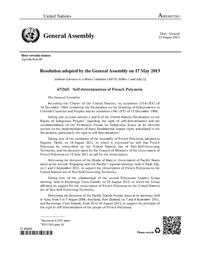
| Wikisource has original text related to this article: |
French Polynesia (![]() i/ˈfrɛntʃ pɒlɨˈniːʒə/; French: Polynésie française, pronounced: [pɔlinezi fʁɑ̃sɛz]; Tahitian: Pōrīnetia Farāni) is an overseas collectivity of the French Republic; collectivité d'outre-mer de la République française (COM), sometimes unofficially referred to as an overseas country; pays d'outre-mer (POM). It is composed of 118 geographically dispersed islands and atolls stretching over an expanse of more than 2,000 kilometres (1,200 mi) in the South Pacific Ocean. Its total land area is 4,167 square kilometres (1,609 sq mi).
i/ˈfrɛntʃ pɒlɨˈniːʒə/; French: Polynésie française, pronounced: [pɔlinezi fʁɑ̃sɛz]; Tahitian: Pōrīnetia Farāni) is an overseas collectivity of the French Republic; collectivité d'outre-mer de la République française (COM), sometimes unofficially referred to as an overseas country; pays d'outre-mer (POM). It is composed of 118 geographically dispersed islands and atolls stretching over an expanse of more than 2,000 kilometres (1,200 mi) in the South Pacific Ocean. Its total land area is 4,167 square kilometres (1,609 sq mi).
French Polynesia is divided into 5 groups of islands: The Society Islands archipelago composed of the Windward Islands and the Leeward Islands, the Tuamotu Archipelago, the Gambier Islands, the Marquesas Islands and the Austral Islands. Among its 118 islands and atolls, 67 are inhabited. Tahiti, which is located within the Society Islands, is the most populous island and the seat of the capital of the collectivity, Pape'ete. Although not an integral part of its territory, Clipperton Island was administered from French Polynesia until 2007.
Following the Great Polynesian Migration, European explorers visited the islands of French Polynesia on several occasions. In 1842, the French took over the islands and established a French protectorate they called Etablissements des français en Océanie (EFO) (French Establishments/Settlements in Oceania). In 1946, the EFOs became an overseas territory under the constitution of the French Fourth Republic, and Polynesians were granted the right to vote through citizenship. In 1957, the EFOs were renamed French Polynesia. Since 28 March 2003, French Polynesia has been an overseas collectivity of the French Republic under the constitutional revision of article 74, and later gained, with law 2004-192 of 27 February 2004, an administrative autonomy; two symbolic manifestations of which are the title of the President of French Polynesia and its additional designation as an overseas country.[5]
History
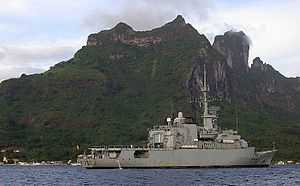
French Polynesia as we know it today was one of the last places on Earth to be settled by humans. Scientists believe the Great Polynesian Migration happened around 1500 BC as Austronesian people went on a journey using celestial navigation to find islands in the South Pacific ocean. The first islands of French Polynesia to be settled were the Marquesas Islands in about 200 BC. The Polynesians later ventured southwest and discovered the Society Islands around AD 300.[6]
European communication began in 1521 when Portuguese explorer Ferdinand Magellan, sailing in the service of the Spanish Crown, sighted Puka-Puka in the Tuāmotu-Gambier Archipelago. In 1772, Dutchman Jakob Roggeveen came across Bora Bora in the Society Islands.
British explorer Samuel Wallis visited Tahiti in 1767. The French explorer Louis Antoine de Bougainville visited Tahiti in 1768, while the British explorer James Cook visited in 1769.[6] In 1772, The Spanish Viceroy of Peru Don Manuel de Amat ordered a number of expeditions to Tahiti under the command of Domingo de Bonechea who was the first European to explore all of the main islands beyond Tahiti.[7] A short-lived Spanish settlement was created in 1774.[6] and for a time some maps bore the name Isla de Amat after Viceroy Amat. Christian missions began with Spanish priests who stayed in Tahiti for a year. Protestants from the London Missionary Society settled permanently in Polynesia in 1797.

King Pōmare II of Tahiti was forced to flee to Mo'orea in 1803; he and his subjects were converted to Protestantism in 1812. French Catholic missionaries arrived on Tahiti in 1834; their expulsion in 1836 caused France to send a gunboat in 1838. In 1842, Tahiti and Tahuata were declared a French protectorate, to allow Catholic missionaries to work undisturbed. The capital of Papeetē was founded in 1843. In 1880, France annexed Tahiti, changing the status from that of a protectorate to that of a colony. The island groups were not officially united until the establishment of the French protectorate in 1889.[8]
In the 1880s, France claimed the Tuamotu Archipelago, which formerly belonged to the Pōmare Dynasty, without formally annexing it. Having declared a protectorate over Tahuata in 1842, the French regarded the entire Marquesas Islands as French. In 1885, France appointed a governor and established a general council, thus giving it the proper administration for a colony. The islands of Rimatara and Rūrutu unsuccessfully lobbied for British protection in 1888, so in 1889 they were annexed by France. Postage stamps were first issued in the colony in 1892. The first official name for the colony was Établissements de l'Océanie (Establishments in Oceania); in 1903 the general council was changed to an advisory council and the colony's name was changed to Établissements Français de l'Océanie (French Establishments in Oceania).[9]
In 1940, the administration of French Polynesia recognised the Free French Forces and many Polynesians served in World War II. Unknown at the time to the French and Polynesians, the Konoe Cabinet in Imperial Japan on 16 September 1940 included French Polynesia among the many territories which were to become Japanese possessions in the post-war world.[10] However in the course of the war in the Pacific the Japanese were not able to launch an actual invasion of the French islands.
In 1946, Polynesians were granted French citizenship and the islands' status was changed to an overseas territory; the islands' name was changed in 1957 to Polynésie Française (French Polynesia). In 1962, France's early nuclear testing ground of Algeria became independent and the Moruroa atoll in the Tuamotu Archipelago was selected as the new testing site; tests were conducted underground after 1974.[11] In 1977, French Polynesia was granted partial internal autonomy; in 1984, the autonomy was extended. French Polynesia became a full overseas collectivity of France in 2003.[12]
In September 1995, France stirred up widespread protests by resuming nuclear testing at Fangataufa atoll after a three-year moratorium. The last test was on 27 January 1996. On 29 January 1996, France announced that it would accede to the Comprehensive Test Ban Treaty, and no longer test nuclear weapons.[13]
Governance
Politics of French Polynesia takes place in a framework of a parliamentary representative democratic French overseas collectivity, whereby the President of French Polynesia is the head of government, and of a multi-party system. Executive power is exercised by the government. Legislative power is vested in both the government and the Assembly of French Polynesia (the territorial assembly).
Political life in French Polynesia has been marked by great instability since the mid-2000s. On 14 September 2007, the pro-independence leader Oscar Temaru, was elected president of French Polynesia for the third time in three years (with 27 of 44 votes cast in the territorial assembly).[14] He replaced former president Gaston Tong Sang, opposed to independence, who lost a no-confidence vote in the Assembly of French Polynesia on 31 August after the longtime former president of French Polynesia, Gaston Flosse, hitherto opposed to independence, sided with his long enemy Oscar Temaru to topple the government of Gaston Tong Sang. Oscar Temaru, however, had no stable majority in the Assembly of French Polynesia, and new territorial elections were held in February 2008 to solve the political crisis.
The party of Gaston Tong Sang won the territorial elections, but that did not solve the political crisis: the two minority parties of Oscar Temaru and Gaston Flosse, who together have one more member in the territorial assembly than the political party of Gaston Tong Sang, allied to prevent Gaston Tong Sang from becoming president of French Polynesia. Gaston Flosse was then elected president of French Polynesia by the territorial assembly on 23 February 2008 with the support of the pro-independence party led by Oscar Temaru, while Oscar Temaru was elected speaker of the territorial assembly with the support of the anti-independence party led by Gaston Flosse. Both formed a coalition cabinet. Many observers doubted that the alliance between the anti-independence Gaston Flosse and the pro-independence Oscar Temaru, designed to prevent Gaston Tong Sang from becoming president of French Polynesia, could last very long.[15]
At the French municipal elections held in March 2008, several prominent mayors who are member of the Flosse-Temaru coalition lost their offices in key municipalities of French Polynesia, which was interpreted as a disapproval of the way Gaston Tong Sang, whose party French Polynesian voters had placed first in the territorial elections the month before, had been prevented from becoming president of French Polynesia by the last minute alliance between Flosse and Temaru's parties. Eventually, on 15 April 2008 the government of Gaston Flosse was toppled by a constructive vote of no confidence in the territorial assembly when two members of the Flosse-Temaru coalition left the coalition and sided with Tong Sang's party. Gaston Tong Sang was elected president of French Polynesia as a result of this constructive vote of no confidence, but his majority in the territorial assembly is very narrow. He offered posts in his cabinet to Flosse and Temaru's parties which they both refused. Gaston Tong Sang has called all parties to help end the instability in local politics, a prerequisite to attract foreign investors needed to develop the local economy.
Relations with France
Despite a local assembly and government, French Polynesia is not in a free association with France, like the Cook Islands with New Zealand. As a French overseas collectivity, the local government has no competence in justice, education, security and defense. Services in these areas are directly provided and administered by the Government of France, including the Gendarmerie (which also polices rural and border areas in European France), and French military forces. The collectivity government retains control over health, town planning, and the environment.[16] The highest representative of the State in the territory is the High Commissioner of the Republic in French Polynesia (French: Haut commissaire de la République).
French Polynesia also sends three deputies to the French National Assembly, one representing the Leeward Islands administrative subdivision and the south-western suburbs of Papeete, another one representing Papeete and its north-eastern suburbs, plus the commune (municipality) of Mo'orea-Mai'ao, the Tuāmotu-Gambier administrative division, and the Marquesas Islands administrative division, and the last one representing the rest of Tahiti and the Austral Islands administrative subdivision. French Polynesia also sends two senators to the French Senate.
French Polynesians vote in the French presidential elections and at the 2007 French presidential election, in which the pro-independence leader Oscar Temaru openly called to vote for the Socialist candidate Ségolène Royal while the parties opposed to independence generally supported the center-right candidate Nicolas Sarkozy, the turnout in French Polynesia was 69.12% in the first round of the election and 74.67% in the second round In favour of Nicolas Sarkozy ahead in both rounds of the election expressing their will to remain in the French Republic. (versus in Metropolitan France in the 2nd round: Nicolas Sarkozy 51.9%; Ségolène Royal 48.1%).[17]
Administration
Between 1946 and 2003, French Polynesia had the status of an overseas territory (French: territoire d'outre-mer, or TOM). In 2003, it became an overseas collectivity (French: collectivité d'outre-mer, or COM). Its statutory law of 27 February 2004 gives it the particular designation of overseas country inside the Republic (French: pays d'outre-mer au sein de la République, or POM), but without legal modification of its status.
Administrative divisions
French Polynesia has five administrative subdivisions (French: subdivisions administratives):
- Marquesas Islands (French: (les) (Îles) Marquises or officially la subdivision administrative des (Îles) Marquises)
- Leeward Islands (French: (les) Îles Sous-le-Vent or officially la subdivision administrative des Îles Sous-le-Vent) (the two subdivisions administratives Windward Islands and Leeward Islands are part of the Society Islands)
- Windward Islands (French: (les) Îles du Vent or officially la subdivision administrative des Îles du Vent) (the two subdivisions administratives Windward Islands and Leeward Islands are part of the Society Islands)
- Tuāmotu-Gambier (French: (les) (Îles) Tuamotu-Gambier or officially la subdivision administrative des (Îles) Tuamotu-Gambier) (the Tuamotus and the Gambier Islands)
- Austral Islands (French: (les) (Îles) Australes or officially la subdivision administrative des (Îles) Australes) (including the Bass Islands)
Geography
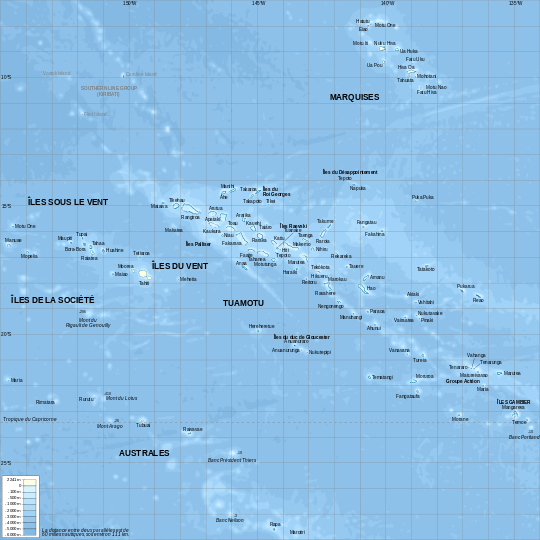
The islands of French Polynesia make up a total land area of 3,521 square kilometres (1,359 sq mi),[2] scattered over more than 2,000 kilometres (1,200 mi) of ocean. There are 118 islands in French Polynesia. The highest point is Mount Orohena on Tahiti.
It is made up of 5 groups of islands. The largest and most populated island is Tahiti, in the Society Islands.
The island groups are:
- Marquesas Islands
- Society Islands
- Tuamotu Archipelago
- Gambier Islands sometimes considered part of the Tuamotu Archipelago
- Austral Islands
- Bass Islands often considered part of the Austral Islands
Aside from Tahiti, some other important atolls, islands, and island groups in French Polynesia are: Ahē, Bora Bora, Hiva 'Oa, Huahine, Mai'ao, Maupiti, Meheti'a, Mo'orea, Nuku Hiva, Raiatea, Taha'a, Tetiaroa, Tupua'i, and Tūpai.
| Commune | Island | Population (2012) |
|---|---|---|
| Fa'a'ā | Tahiti | 29,687 |
| Punaauia | Tahiti | 27,613 |
| Pape'ete | Tahiti | 25,769 |
Economy
.jpg)
The GDP of French Polynesia in 2008 was 7.14 billion US dollars at market exchange rates, the sixth-largest economy in Oceania after Australia, New Zealand, Hawaii, New Caledonia, and Papua New Guinea.[4] The GDP per capita was $27,352 in 2008 (at market exchange rates, not at PPP), lower than in Hawaii, Australia, New Zealand, and New Caledonia, but higher than all the independent insular states of Oceania.[4]
French Polynesia has a moderately developed economy, which is dependent on imported goods, tourism, and the financial assistance of mainland France. Tourist facilities are well developed and are available on the major islands. Also, as the noni fruit from these islands is discovered for its medicinal uses, people have been able to find jobs related to this agricultural industry.
The legal tender of French Polynesia is the CFP Franc.
Agriculture: coconuts, vanilla, vegetables, fruits.
Natural resources: timber, fish, cobalt.
In 2008, French Polynesia's imports amounted to 2.2 billion US dollars and exports amounted to 0.2 billion US dollars.[18] The major export of French Polynesia is their famous black Tahitian pearls which accounted for 55% of exports (in value) in 2008.[18]
Demographics

Total population at the August 2012 census was 268,270 inhabitants.[3] At the 2012 census, 68.5% of the population of French Polynesia lived on the island of Tahiti alone.[3] The urban area of Papeete, the capital city, has 133,627 inhabitants (2012 census).
At the 2007 census, 87.3% of people living in French Polynesia were born in French Polynesia, 9.3% were born in metropolitan France, 1.4% were born in overseas France outside of French Polynesia, and 2.0% were born in foreign countries.[19] At the 1988 census, the last census which asked questions regarding ethnicity, 66.5% of people were ethnically unmixed Polynesians, 7.1% were ethnically mixed Polynesians, 11.9% were Europeans (mostly French), 9.3% were people of mixed French and Polynesian descent, the so-called Demis (literally meaning "Half"), and 4.7% were East Asians (mainly Chinese).[1]
Chinese, Demis, and the white populace are essentially concentrated on the island of Tahiti, particularly in the urban area of Papeetē, where their share of the population is thus much greater than in French Polynesia overall.[1] Despite a long history of ethnic mixing, ethnic tensions have been growing in recent years, with politicians using a xenophobic discourse and fanning the flame of nationalism.[20][21]
Historical population
| 1907 | 1911 | 1921 | 1926 | 1931 | 1936 | 1941 | 1946 | 1951 | 1956 | ||||
|---|---|---|---|---|---|---|---|---|---|---|---|---|---|
| 30,600 | 31,900 | 31,600 | 35,900 | 40,400 | 44,000 | 51,200 | 58,200 | 63,300 | 76,323 | ||||
| 1962 | 1971 | 1977 | 1983 | 1988 | 1996 | 2002 | 2007 | 2012 | |||||
| 84,551 | 119,168 | 137,382 | 166,753 | 188,814 | 219,521 | 245,516 | 259,596 | 268,270 | |||||
| Official figures from past censuses.[3][22][23][24] | |||||||||||||
Languages

French is the only official language of French Polynesia.[25] An organic law of 12 April 1996 states that "French is the official language, Tahitian and other Polynesian languages can be used." At the 2007 census, among the population whose age was 15 and older, 68.5% of people reported that the language they spoke the most at home was French, 24.2% reported that the language they spoke the most at home was Tahitian, 2.6% reported Marquesan, 1.5% reported Tuamotuan, 1.3% reported any of the Austral languages, 1.0% reported a Chinese dialect (half of which is still Hakka), and 0.9% another language.[26]
At the same census, 94.7% of people whose age was 15 or older reported that they could speak, read and write French, whereas only 2.0% reported that they had no knowledge of French.[26] 86.4% of people whose age was 15 or older reported that they had some form of knowledge of at least one Polynesian language, whereas 13.6% reported that they had no knowledge of any of the Polynesian languages.[26]
Religion
Christianity is the main religion of the islands: a majority (54%) belong to various Protestant churches and a large minority (30%) are Roman Catholic. Slightly more than 50% of French Polynesia's population belongs to the Maói Protestant Church, the largest Protestant denomination.[27] The Church of Jesus Christ of Latter-day Saints had 21,884 members as of 2012.[28] There were about 3,000 Jehovah's Witnesses in Tahiti as of 2014.[29]
Transportation
There are 53 airports in French Polynesia; 46 are paved.[12] The Faaa International Airport is the only international airport in French Polynesia. Each island has its own airport that serves flights to other islands. Air Tahiti is the main airline that flies around the islands.
Notable people
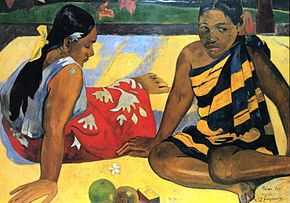
- Vaitiare Hirson-Asars (born 1964), actress
- Cheyenne Brando (1970–1995), model, daughter of Marlon Brando and Tarita Teriipaia
- Tuki Brando (born 1990), model, son of Cheyenne Brando
- Jacques Brel (1929–1978), Belgian musician who lived in French Polynesia near the end of his life.
- Jean Gabilou, singer (born 1944), represented France in the 1981 Eurovision Song Contest.
- Paul Gauguin (1848–1903), French impressionist painter who spent the last years of his life in French Polynesia.
- Maréva Georges, model, former Miss Tahiti 1990 and Miss France 1991.
- Pouvāna'a 'Ō'opa (1895–1977), politician and Tahitian nationalist.
- Henri Hiro (1944–1991), film director and script writer, poet, ecologist, activist.
- Ella Koon (born 1979), singer, actor and model.
- Karina Lombard (born 1969), French-American model
- Marco Namouro (1889–1968), writer.
- Fabrice Santoro (born 1972), professional tennis player.
- Tarita Teriipaia (born 1941), actress, third wife of Marlon Brando
- Marama Vahirua (born 1980), footballer, cousin of Pascal Vahirua.
- Pascal Vahirua (born 1966), French former international footballer.
- Célestine Hitiura Vaite (born 1966), writer.
Music
French Polynesia came to the forefront of the world music scene in 1992, with the release of The Tahitian Choir's recordings of unaccompanied vocal Christian music called himene tārava, recorded by French musicologist Pascal Nabet-Meyer. This form of singing is common in French Polynesia and the Cook Islands, and is distinguished by a unique drop in pitch at the end of the phrases, which is a characteristic formed by several different voices; it is also accompanied by steady grunting of staccato, nonsensical syllables.
See also
- Outline of French Polynesia
- Index of French Polynesia-related articles
- Colonial and Departmental Heads of French Polynesia
- French colonial empire
- List of French possessions and colonies
- List of islands
References
- ↑ 1.0 1.1 1.2 Most recent ethnic census, in 1988. "Frontières ethniques et redéfinition du cadre politique à Tahiti" (PDF). Retrieved 31 May 2011.
- ↑ 2.0 2.1 "R1- Population sans doubles comptes, des subdivisions, communes et communes associées de Polynésie française, de 1971 à 1996". ISPF. Retrieved 13 October 2013.
- ↑ 3.0 3.1 3.2 3.3 "Population des communes de Polynésie française". INSEE. Retrieved 13 October 2013.
- ↑ 4.0 4.1 4.2 4.3 "COMPTES ÉCONOMIQUES 2008 - Polynésie française" (in French). ISPF. Retrieved 13 October 2013.
- ↑ http://www.collectivites-locales.gouv.fr/statuts-nouvelle-caledonie-et-polynesie#statut_pol_fcse
- ↑ 6.0 6.1 6.2 Ganse, Alexander. "History of Polynesia, before 1797". Archived from the original on 30 December 2007. Retrieved 20 October 2007.
- ↑ Kirk, Robert K. id=klglH_7KkxsC&pg=PA43&lpg=PA43&dq=manuel+de+amat+tahiti&source=bl&ots=D__pDUnHpY&sig=yW9d0c9CQiF4LzLjDaoymBrOgzs&hl=es&sa=X&ei=q8eGUa3nHdPb7AbdqIHABQ&ved=0CGIQ6AEwBw#v=onepage&q=manuel%20de%20amat%20tahiti&f=false Paradise Past: The Transformation of the South Pacific, 1520-1920. Retrieved 5 May 2013.
- ↑ Ganse, Alexander. "History of French Polynesia, 1797 to 1889". Archived from the original on 30 December 2007. Retrieved 20 October 2007.
- ↑ Ganse, Alexander. "History of French Polynesia, 1889 to 1918". Archived from the original on 30 December 2007. Retrieved 20 October 2007.
- ↑ The Japanese claim to the French Pacific islands, along with many other vast territories, appears in 16 September 1940 "Sphere of survival for the Establishment of a New Order in Greater East Asia by Imperial Japan", published in 1955 by Japan's Foreign Ministry as part of the two-volume "Chronology and major documents of Diplomacy of Japan 1840–1945" – here quoted from "Interview with Tetsuzo Fuwa: Japan's War: History of Expansionism", Japan Press Service, July 2007
- ↑ Ganse, Alexander. "History of Polynesia, 1939 to 1977". Archived from the original on 30 December 2007. Retrieved 20 October 2007.
- ↑ 12.0 12.1 French Polynesia entry at The World Factbook. Retrieved 25 September 2012.
- ↑ Whitney, Craig R (30 January 1996). "France Ending Nuclear Tests That Caused Broad Protests". The New York Times. Retrieved 20 October 2007.
- ↑ "BBC NEWS, French Polynesia gets new leader". BBC News. 14 September 2007. Retrieved 31 May 2011.
- ↑ http://www.rfo.fr/article1437.html
- ↑ http://thediplomat.com/2012/10/french-polynesia-last-vestiges-of-frances-empire/
- ↑ Minister of the Interior, Government of France. "POLYNESIE FRANCAISE (987) (résultats officiels)" (in French). Retrieved 14 September 2007.
- ↑ 18.0 18.1 Institut d'émission d'Outre-Mer (IEOM). "La Polynésie française en 2008" (PDF) (in French). Retrieved 14 September 2009.
- ↑ Institut Statistique de Polynésie Française (ISPF). "Recensement 2007 – Migrations : Chiffres clés" (in French). Retrieved 15 November 2008.
- ↑ "Logiques " autonomiste " et " indépendantiste " en Polynésie française". Conflits.org. Retrieved 31 May 2011.
- ↑ "Temaru-Flosse: le rebond du nationalisme tahitien". Rue89.com. 19 January 2011. Retrieved 31 May 2011.
- ↑ "Population des communes de Polynésie française au RP 2007". INSEE. Retrieved 13 October 2013.
- ↑ "Population statistique des communes et communes associées aux recensements de 1971 à 2002". ISPF. Retrieved 13 October 2013.
- ↑ Censuses from 1907 to 1962 in Population, 1972, #4–5, pp. 705–706, published by INED
- ↑ Le tahitien reste interdit à l'assemblée de Polynésie, RFO, 6 October 2010
- ↑ 26.0 26.1 26.2 Institut Statistique de Polynésie Française (ISPF). "Recensement 2007 – Langues : Chiffres clés" (in French). Retrieved 13 October 2013.
- ↑ "http://www.webcitation.org/64LUkdnR5". Tahitipresse. 26 July 2010. Retrieved 31 December 2011.
- ↑ LDS Newsroom Statistical Information. Retrieved 23 September 2012.
- ↑ 2015 Yearbook of Jehovah's Witnesses. Watch Tower Society. p. 186.
Bibliography
- Danielsson, Bengt (1965). Work and Life on Raroia: An Acculturation Study from the Tuamotu Group, French Oceania. London: G. Allen & Unwin.
- Danielsson, Bengt; Marie-Thérèse Danielsson (1986). Poisoned Reign: French Nuclear Colonialism in the Pacific. New York: Penguin Books. ISBN 0-14-008130-5.
- Hough, Richard (1995). Captain James Cook. W W Norton. ISBN 0-393-03680-4.
- Pollock, Nancy J.; Ron Crocombe, eds. (1988). French Polynesia: A Book of Selected Readings. Suva, Fiji: Institute of Pacific Studies of the University of the South Pacific. ISBN 982-02-0032-6.
- Thompson, Virginia; Richard Adloff (1971). The French Pacific Islands: French Polynesia and New Caledonia. Berkeley: University of California Press.
- Aldrich, Robert (1990). The French Presence in the South Pacific, 1842–1940. Sydney.
- Aldrich, Robert (1993). France and the South Pacific since 1940. Sydney.
- James Rogers and Luis Simón. The Status and Location of the Military Installations of the Member States of the European Union and Their Potential Role for the European Security and Defence Policy (ESDP). Brussels: European Parliament, 2009. 25 pp.
- Jean-Marc Régnault, Le pouvoir confisqué en Polynésie française. L'affrontement Temaru-Flosse. Les Indes savantes, 2005.
External links
| The Wikibook Geography of France has a page on the topic of: French Polynesia |
- Government
- Government of French Polynesia
- Presidency of French Polynesia
- Administrative Subdivisions of French Polynesia
- General information
- (French) Encyclopédie collaborative du patrimoine culturel et naturel polynésien
- French Polynesia entry at The World Factbook
- French Polynesia at UCB Libraries GovPubs
- French Polynesia at DMOZ
 Wikimedia Atlas of French Polynesia
Wikimedia Atlas of French Polynesia
- Travel
| ||||||||||||||||||||||||||||||||||||||||||
| ||||||||||||||||||||||||||||||||||||||||||||||||||||||||||||||||||||||||||||||||||||||||||||||||||||||||||||||||||||||||||||||||||||||||||||||||||||||||||||||||||||||||||
| |||||||||||||||||||||||||||||||||||||||||||||||||

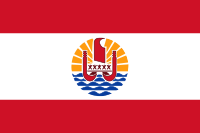
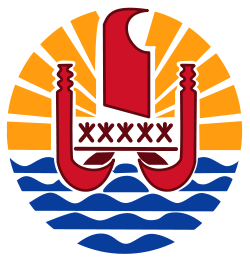
.svg.png)
